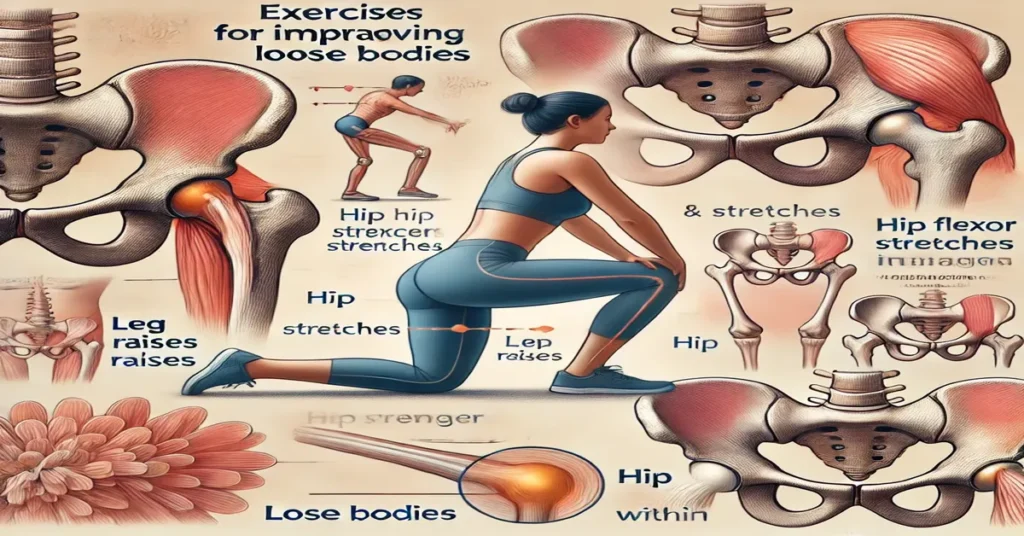loose bodies exercise in the hip in the hip are a relatively common issue, often causing discomfort, limited movement, and pain. While the term “loose bodies” may sound concerning, it refers to small pieces of cartilage, bone, or other debris that can become dislodged and float inside the joint. The hip joint, being a ball-and-socket joint, is susceptible to these occurrences, especially in individuals who engage in high-impact sports or have underlying joint conditions.
The goal of this article is to delve into the concept of loose bodies in the hip, how they affect mobility and health, and how specific exercises can help manage and potentially alleviate the discomfort associated with loose bodies in the hip joint. By understanding the causes, symptoms, and potential treatments—including exercise-based interventions—individuals can take steps toward managing their hip health.
What Are Loose Bodies in the Hip?
Loose bodies in the hip joint refer to small fragments of bone or cartilage that become detached and float freely within the joint capsule. These fragments can vary in size and are typically the result of wear and tear on the joint or an injury. The medical term for this condition is osteochondritis dissecans (OCD) or joint mice, although the term “loose bodies” is often used to describe these debris in common language.
There are several possible causes for loose bodies to form in the hip joint, including:
- Degenerative Joint Conditions: Over time, the cartilage in the hip joint can wear down, leading to the formation of small fragments that break off and float in the joint. Conditions such as osteoarthritis and rheumatoid arthritis can cause this degradation.
- Traumatic Injury: A hip fracture, dislocation, or other traumatic injury can cause cartilage or bone to break away, creating loose bodies in the joint.
- Congenital Disorders: In some cases, individuals may be born with structural issues in their joints that make them more susceptible to loose bodies. These issues might include abnormal cartilage development or hip dysplasia.
- Inflammatory Joint Diseases: Conditions like gout or infections can cause swelling and inflammation in the hip joint, leading to the detachment of bone or cartilage fragments.
Symptoms of Loose Bodies in the Hip
The symptoms of loose bodies in the hip joint can range from mild to severe, depending on the size of the fragments and their impact on joint movement. Common symptoms include:
- Pain: The most common symptom of loose bodies in the hip is pain, which may occur in the groin, thigh, or buttocks area. The pain may be intermittent or persistent, worsening with activity.
- Limited Range of Motion: Loose bodies can interfere with the smooth movement of the hip joint, causing stiffness and difficulty in fully extending or flexing the hip. Activities like squatting, bending, or walking may become challenging.
- Locking or Catching Sensation: In some cases, individuals may experience a sensation of the hip “locking” or “catching” when walking or moving. This occurs when the loose bodies move within the joint and temporarily block movement.
- Swelling: Inflammation in the joint may occur as a response to the loose bodies, leading to visible swelling or tenderness around the hip.
- Instability: The hip may feel unstable, especially during physical activities that involve weight-bearing or sudden movements.
How Loose Bodies Affect the Hip Joint
The presence of loose bodies within the hip joint can have a significant impact on the joint’s function and overall health. Here’s how these floating fragments affect the hip:
- Impaired Joint Function: The smooth movement of the ball-and-socket joint depends on the integrity of the cartilage and bones. Loose bodies can disrupt the normal movement patterns, causing friction, discomfort, and difficulty with everyday activities like walking or climbing stairs.
- Increased Wear and Tear: As loose bodies move within the joint, they can scrape against the cartilage and other structures, leading to further joint damage over time. This can exacerbate symptoms of osteoarthritis, where the cartilage in the joint deteriorates.
- Chronic Pain: If the loose bodies are large or positioned in such a way that they frequently interfere with normal movement, they can cause ongoing pain. This can be particularly problematic for active individuals who want to maintain an active lifestyle.
- Potential for Joint Deformity: Over time, the continual movement of loose bodies and the associated wear and tear on the joint can lead to joint deformities, making the hip joint even more dysfunctional. This may ultimately lead to the need for joint replacement surgery.
Treatment for Loose Bodies in the Hip
Treatment for loose bodies in the hip typically depends on the severity of the condition and the individual’s symptoms. The main treatment options are non-surgical and surgical:
1. Non-Surgical Management
In some cases, especially when symptoms are mild or intermittent, non-surgical treatments may be recommended. These treatments focus on managing pain, improving mobility, and maintaining overall joint health.
a. Physical Therapy and Exercise
Physical therapy is one of the most effective non-surgical treatment options for loose bodies in the hip. Through targeted exercises, individuals can strengthen the muscles around the hip joint, improve joint stability, and increase flexibility.
Key exercises to consider include:
- Hip Flexor Stretch: Stretching the hip flexors can help improve flexibility and range of motion. This exercise targets the muscles that may be tight due to restricted hip movement caused by loose bodies.
- Hip Abduction: This exercise strengthens the hip muscles, which can provide support to the joint and reduce strain caused by the loose bodies. This is important for restoring stability to the hip.
- Bridges: The bridge exercise helps strengthen the glute muscles and core, which play an essential role in maintaining hip stability and function.
- Leg Raises: Leg raises are excellent for improving the strength of the hip flexors and lower abdominal muscles, which support the joint.
- Squats: Properly performed squats help build strength in the quadriceps and glutes, which are essential for overall hip function and support.
b. Medications
Nonsteroidal anti-inflammatory drugs (NSAIDs) or pain relievers may be used to alleviate pain and reduce inflammation. Injections of corticosteroids into the hip joint can also provide relief from pain and swelling.
c. Lifestyle Modifications
Maintaining a healthy weight, using assistive devices like canes if necessary, and avoiding high-impact activities that may aggravate the condition can also help manage symptoms.
2. Surgical Treatment
If non-surgical treatments do not provide sufficient relief or if the loose bodies cause significant interference with the joint’s function, surgery may be required. The two main surgical options include:
a. Arthroscopic Surgery
Arthroscopic surgery is a minimally invasive procedure that uses small incisions and a camera to visualize the inside of the joint. The surgeon can remove the loose bodies and address any damaged cartilage or tissue. This is often the preferred surgical method as it involves less recovery time compared to traditional open surgery.
b. Hip Replacement Surgery
In more severe cases where the hip joint is extensively damaged or the loose bodies have caused irreparable damage, a hip replacement may be necessary. This surgery involves removing the damaged joint and replacing it with an artificial hip joint.
How to Manage Loose Bodies in the Hip Through Exercise
Exercise plays a key role in managing symptoms associated with loose bodies in the hip. While exercise alone cannot eliminate the loose bodies, it can help with pain management, muscle strengthening, and restoring mobility.
1. Strengthening Muscles Around the Hip
By strengthening the muscles around the hip joint, exercise can help stabilize the area and reduce the pressure placed on the joint. Strong muscles can compensate for joint dysfunction and help reduce pain.
2. Increasing Flexibility
Stretching exercises can increase the flexibility of the hip joint and surrounding muscles, improving range of motion. This can alleviate the stiffness and discomfort caused by loose bodies.
3. Improving Balance and Coordination
Exercises that focus on balance and coordination can help reduce the risk of falls or injury, especially for individuals who experience instability in the hip joint due to the loose bodies.
4. Reducing Joint Stress
Low-impact exercises, such as swimming, cycling, and walking, can provide cardiovascular benefits while minimizing stress on the hip joint. These activities help maintain fitness without exacerbating the symptoms of loose bodies.
Conclusion
Loose bodies in the hip can significantly affect an individual’s quality of life, causing pain, discomfort, and reduced mobility. However, understanding the causes, symptoms, and treatment options—particularly the role of exercises—can help individuals manage their condition effectively.
While some people may require surgical intervention, many individuals with loose bodies in the hip can benefit from physical therapy, exercise, and lifestyle modifications. These treatments can improve muscle strength, flexibility, and joint function, ultimately alleviating pain and improving overall joint health.
Whether you are dealing with mild symptoms or more severe discomfort, it’s important to work closely with a healthcare professional to determine the best treatment plan for your condition. With the right combination of therapies, you can reduce the impact of loose bodies and restore function to your hip joint, improving both your mobility and quality of life.
FAQs About Loose Bodies Exercise in the Hip
- What are loose bodies in the hip? Loose bodies in the hip are fragments of bone or cartilage that break off and float within the joint, leading to pain and reduced mobility.
- How do I know if I have loose bodies in my hip? Symptoms include pain, limited range of motion, joint locking, and swelling. A doctor can confirm the diagnosis through imaging techniques such as X-rays or MRI scans.
- Can exercise help manage the symptoms of loose bodies in the hip? Yes, exercises that strengthen the muscles around the hip and improve flexibility can help reduce pain and improve joint function.
- What exercises are recommended for loose bodies in the hip? Exercises such as hip flexor stretches, hip abduction, bridges, leg raises, and squats can help strengthen the hip muscles and improve flexibility.
- When should I consider surgery for loose bodies in the hip? If non-surgical treatments do not relieve symptoms or if the loose bodies cause significant joint damage, surgical intervention, such as arthroscopic surgery or hip replacement, may be necessary.
- Are there any lifestyle changes that can help manage loose bodies in the hip? Yes, maintaining a healthy weight, avoiding high-impact activities, and using assistive devices when necessary can help reduce strain on the hip joint and manage symptoms effectively.







